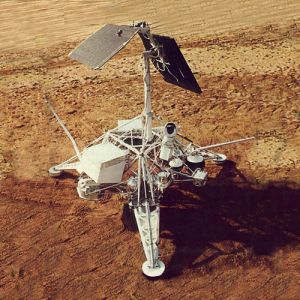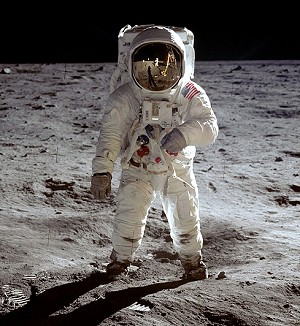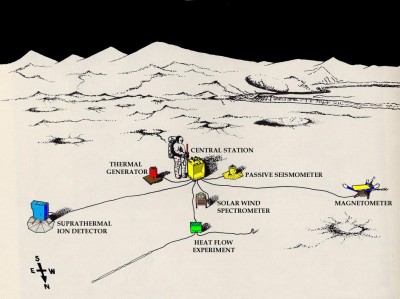The Moon
The first planetary seismology experiments were carried out on Earth’s natural satellite, the Moon
-
 Ranger probe (© NASA)
Ranger probe (© NASA)
Planetary seismology really took off in the early 1960s with the US Ranger mission, designed to send a series of spacecraft to the Moon on a collision course so that they could photograph the lunar surface up to the moment of impact. To fulfil their mission, the probes were bristling with cameras, but seismometers had also been flown on the second series, Ranger 3, 4 and 5.
The Ranger probes’ brutal approach to the Moon does not appear very compatible with the exploitation of a seismometer, a device that by definition is extremely sensitive to the slightest bump. NASA engineers had nonetheless designed a balsa wood sphere able to resist a rough landing on the lunar soil, and it was inside this protective sphere that the seismometer was placed.
The Ranger programme was a serious setback for NASA, because of the 9 probes launched from Earth, none managed to fulfil its mission due to various malfunctions, either on launch or during the guidance phase on their journey to the Moon.
Flying a seismometer, Ranger 3 missed its target after its launch on 26 January 1962 and was lost somewhere in outer space. Ranger 5’s fate was exactly the same, 9 months later. A failure in Ranger 4’s onboard computer deprived the spacecraft of its solar arrays and navigation capabilities, so it unfortunately crashed into the Moon and no scientific data were ever recovered.
Last updated: 25 October 2016
-
 Model of the Surveyor lunar probe (© NASA)
Model of the Surveyor lunar probe (© NASA)
For the scientists investigating seismic activity on the Moon, the logical follow-on to Ranger would have been to fly seismometers on the Surveyor spacecraft.
The Surveyor programme absolutely had to succeed, NASA having no further room for mistakes after the Ranger fiasco. A seismometer was therefore developed, but the project was finally shelved, temporarily curbing the ambitions of geophysicists.
Last updated: 25 October 2016
-
 Portrait of astronaut Buzz Aldrin during the Apollo 11 mission (© NASA).
Portrait of astronaut Buzz Aldrin during the Apollo 11 mission (© NASA).
Apollo 11
The first lunar seismometer was finally placed on the Moon’s surface by man rather than a robot, during the Apollo missions. In July 1969, Buzz Aldrin set up the Passive Seismic Experiment (PSE) on the Sea of Tranquillity. As its name suggests, this seismometer listened out for natural seismic noise. It did not use active techniques such as impacts or explosions to generate seismic waves.
PSE, the device that Aldrin set up on the lunar soil, was powered by solar arrays, so it could only operate in sunlight. It ran out of power during the lunar night, so could take no further measurements. During the second lunar day, the midday Sun caused the instrument to overheat and finally fail. It was still able to record seismic activity over 21 Earth days, which is a little less than one lunar day (which lasts 28 Earth days).
The PSE seismometer was sensitive to vibrations in three-dimensional space for long-period waves (three axes), and along one axis for short-period waves. With a mass of 11.5 kg, its power consumption varied between 4.3 and 7.4 watts. It was made of beryllium, a very lightweight metal that is extremely challenging and costly to work with due to its extreme toxicity to humans.
The correct operation of a seismometer is highly dependent on the quality of its installation, and it was thanks to the lessons learned from Apollo 11 that greater care was taken when setting up later seismometers to ensure a more accurate orientation and configuration. The instruments were also covered with thermal insulation to prevent overheating. The solar arrays of the first seismometers were replaced by a radioisotope thermoelectric generator—a device that generates heat through the radioactive decay of unstable atomic nuclei—thus enabling them to continue to operate at night, in the dark.
A network of seismometers set up by Apollo 12, 14, 15 and 16
 Magnetic tape containing the recordings of active seismic events during the Apollo 16 mission (© IPGP).
Magnetic tape containing the recordings of active seismic events during the Apollo 16 mission (© IPGP).
The second, improved, seismometer was set up on the Ocean of Storms by Apollo 12. It was soon joined by other seismic stations at Fra Mauro (Apollo 14), Hadley (Apollo 15) and finally in the highland region north of the ancient Descartes crater (Apollo 16). Together they made up a network of four seismic stations forming a grid over the centre of the visible side of the Moon, thus enabling them to sound its interior structure and characterize the propagation of seismic waves deep within its rocky layers.
In December 1972, the last Apollo mission—Apollo 17—set up a gravimeter in the Taurus-Littrow valley. The objective of this experiment was to measure the gravitational waves predicted by Einstein’s general theory of relativity (which were actually detected for the first time in February 2016 by the US Laser Interferometer Gravitational wave Observatory (LIGO)).
No gravitational waves were observed on the Moon, but geophysicists realised much later that the instrument was not very sensitive because it was acting like a short-period seismometer and that the data sent back to Earth were such that it could actually be considered a fifth seismic station, which was a real windfall. As far as seismology is concerned, the more the merrier!
Lunar experiments ended in September 1977, after nearly 8 years of observation amounting to 600 gigabits of data. Although the seismometers were passive, active seismology experiments were also carried out on the Moon to generate seismic waves on demand.
Active seismology
 Impact site of the Apollo 16 mission's S-IVB rocket stage (©LRO/NASA).
Impact site of the Apollo 16 mission's S-IVB rocket stage (©LRO/NASA).
By deliberately crashing a heavy object, such as the last stage of a Saturn V rocket or the ascent stage of the lunar module (once used, of course) into the Moon, geophysicists could cause impacts to produce seismic waves. The key advantage of this over passive measurements lies in the fact that the source of the tremor could be accurately located on the lunar surface, and the instant of impact known to a split second. Nine controlled-impact experiments were carried out on the Apollo 14, 16 and 17 missions. For this purpose, geophones (which are similar to seismometers) were fitted with small explosive devices.
A review of lunar observations
 Artist's concept of the Apollo 15 ALSEP layout (© NASA).
The first planetary seismology experiments carried out on the dusty grey surface of our natural satellite revealed how noisy the Earth is. With no atmosphere and therefore no weather, no oceans with their breaking waves and pounding of surf along the shoreline, no cities, highways or underground railways, the Moon is a near-silent world. Up there, there is practically nothing to disturb a seismometer, which can therefore measure the slightest ground motion, an impossible achievement on Earth.
Artist's concept of the Apollo 15 ALSEP layout (© NASA).
The first planetary seismology experiments carried out on the dusty grey surface of our natural satellite revealed how noisy the Earth is. With no atmosphere and therefore no weather, no oceans with their breaking waves and pounding of surf along the shoreline, no cities, highways or underground railways, the Moon is a near-silent world. Up there, there is practically nothing to disturb a seismometer, which can therefore measure the slightest ground motion, an impossible achievement on Earth.
Throughout the measurement period, the lunar seismology network recorded a little fewer than 2,000 impacts made by meteorites of different sizes and over 10,000 tremors. Most of these low-magnitude tremors (generally below 2 on the Richter scale) originated in the depths of the Moon, with a focus between 800 and 1,000 kilometres deep.
Studying the propagation of seismic waves inside the Moon has also led to a definition of its interior structure, the end goal of all seismic measurements.
Like other large bodies in the solar system, the Moon is not a homogeneous sphere but is made up of several layers. It has a rocky crust three times thicker than that of Earth, a mantle then a metallic core. Although fairly small in diameter (less than 450 kilometres), the outer part of the lunar core is nonetheless molten. The inner core is solid. The weak attenuation of seismic waves crossing through the mantle suggests that it is cold and dry (low water content).
The Moon confirmed the potential of seismology for studying other planets in the solar system, and the surprises it held for geophysicists—which included the diffraction of seismic waves by the regolith, a layer of heterogeneous broken rocks making up the lunar crust—presages more unexpected discoveries on other planetary bodies, and especially Mars, the Red Planet.
Last updated: 18 september 2017





